

DO KELPIES STILL HAVE AN UNDERCOAT?
It would seem from reports that some of the very earliest Kelpies carried a thick undercoat. Some people called this a double coat. It is supposed to be a thick, softer, short coat below the main coat. Many dog breeds from very cold regions have thick undercoats like this. We have never seen a thick undercoat on any Kelpie and as our family has been involved with the breed for three generations of the Bilson family, you would think if it was even rare, we would have seen quite a few examples by now. With today's Kelpies, we we rarely see any real undercoat at all, excepting some agouti hair.
Obviously we haven't checked every Kelpie we see for thick undercoats but we looked closely at a lot of Working Kelpies in the Australian States of New South Wales, ACT, Victoria, S.A., Tasmania and Queensland. Most have shown no indication at all of any undercoat. Some have had a few, sparse soft short hairs that in a lot of generations back may have possibly been an undercoat. We are not sure why this has changed in the Working Kelpies or even if it ever was common, but it may have something to do with the warmer weather conditions.
Don't get undercoat confused with Agouti. A lot of Working Kelpies have Agouti in their coats. This is banded hair that is light coloured. This is often not very noticeable until the hair is parted and often thought to be undercoat. Some Kelpies however, have a lot of agouti hair on the outside, especially on their underside and around the neck and rump. See the details in another part of this section.
WORKING KELPIES AND COAT LENGTH
Coat length in dogs can be deceiving. A dense coat can look much longer and tend to be wavy then a thin coat. Some Working Kelpies have a coat so thin that if you blow on the hairs you can see the skin. However if you measure the hair length they are often a little longer then the Kelpies with thick coats that look very long.
From our own observations of our own Noonbarra Kelpies as well as many Kelpies from other Studs the hair is longest around the neck and shoulders of the dog. Many old-time handlers have told us that in the 1920's - 1940's the Kelpies had much longer hair around the back legs.
Also sometimes even Kelpies that have been bred pure for many generations can throw a pup that has longish hair. Not extremely long like the long-haired breeds of dogs but still longer than the average Kelpie. The original line of Kelpies back in the 1800's often had dogs with longer and rougher coats than the majority of Kelpies today.
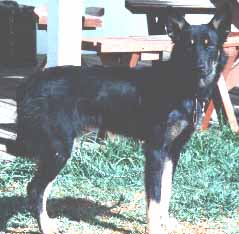
RED COLOURING IN KELPIES
These days, most solid red Kelpies are of the Show Kelpie breed. This is a different breed to the original lines of Working Kelpies. This related show breed broke away from the working lines in the 1920's and 1930's and were bred for the deep solid red colour, looks and to win ribbons for their looks.
The owners liked the rich dark brown colour and did not like any tan marking. These days nearly all the Show Kelpie breed are small, heavy set, dark chocolate coloured dogs. This show breed has been especially developed for looks alone and is a very different dog from the standard Working Kelpie in almost every way. Occasionally they are bought by the general public (especially overseas) mistakenly thinking they are the famous Working Kelpie. This is something we are strongly opposed to. We think they should only be sold as Show animals or Pets.
There are very few full red Kelpies still around that are the old Working Kelpie lines. They have become extremely rare unless they have been bred generation after generation for the colour. Except for a few owned by late Jack Mills and his Waringa Stud in the 1980's, we have not seen any red purebreds for years. Excepting of course the Elfinvale Stud and studs based on their bloodlines. This famous Stud started with a lot solid red coloured Show lines and intermixed them into the Working Kelpie bloodlines. This was a long time ago now but the solid dark red colour still comes through on a lot of their dogs today.
The Red Kelpie is often not really red in colour but closer to brown. King & McLeod's Biddy. (around 1900) was often quoted by Show breeders as being solid red but now from historical photos we know her to be a Red & tan Kelpie. Biddy was a big trial winner and very highly regarded. She was owned and trialled by the famous Stud of King & McLeod.

One of the most famous solid red coloured Kelpies of all time was Red Hope. This dog was born in 1916. Red Hope was a legend in his time and bred many great dogs as well. He was a solid reddish colour with a patch of white on his chest.
This colour became very popular with the Show fanciers and very soon was by far the most popular colour in dog shows. This is still the case today. However, now most Show Kelpies are of the dark chocolate colouring rather than the lighter ginger coloured reds.
What most people refer to as a red Kelpie ranges in colour from a pale ginger colouring to a very dark chocolate. They are also sometimes called brown or mahogany. The Fawn Kelpies are also just diluted reds.
Of the more recent (1950's) good working full red Kelpies was Kanimbla Betty. She was bred by Athol Butler, one of the greatest handlers of all time who also trialled Walkers Johnny and Porters Don. Betty won the Queensland Championship in 1954. Jack Mills (Waringa Stud) also had some success in sheepdog trials with all red kelpies during the 1960's -1980's.
Mr. Tony Parsons wrote the following text in his excellent book 'The Australian Kelpie' published in 1992.
" To make matters worse, Show Kelpie people have this bias towards red dogs. It is much harder to breed a top pure red Kelpie than almost any other colour. In over forty years I have seen only one pure red male that I would describe as a top dog. Red & tans, yes, but not pure red."
"Kanimbla Betty was the best and only top pure red Kelpie trial bitch that I saw, and I have not yet seen a male equivalent. There were some from 1900 to 1940, but few since." - Tony Parsons 1992
WHAT SHOULD A KELPIE EARS LOOK LIKE ?
We get questions about Kelpie ears all the time.
Not all purebred Working Kelpies have pricked ears. Far from it. The breed has never had all pricked ears, even the first Kelpies in the 1800's had ears that either were tipped or went down.
Based on our experience, we would think around 15% - 20% of Working Kelpies today have ears that are not hard pricked up ears. Some may be slightly tipped or one up/one down or both down or even ears that come up sometimes and down the rest of the time. Most of the well established working Kelpie breeders in Australia would have bred some Kelpies with drop down ears. Some people like the ears to be down or tipped and others don't. It really doesn't matter either way. Just like many Border Collie people don't like their dogs to have pricked ears.
This type of cosmetic feature is not considered very important with breeders of real working dogs. The main criteria is always for the best working ability and ears, eyes, tails, markings and coat colour are usually not even a consideration.
It has only been recently that there seems to be an increased emphasis put on what is perceived by society as pretty dogs. We think this is a pity because once that is near the top of your list of priorities then something else, maybe a good working quality, biddability or temperament, falls behind in the selection process. The world already has hundreds of breeds that are selected for colour and looks to perform in dog shows. Surely we don't need to do this to the famous Australian Working Kelpie as well!
In the past, Australian stockmen needed the very best working dog and everything else came a long way second. Working Kelpies don't all look the same. Some are big, some are small, some have broad heads and some fine heads. The beauty of the animal is in the eyes of the beholder. It would be a great pity to see Working Kelpies go the way of most breeds and selected only for uniform looks. This has already been done once before anyway. Back in the 1920's there was a breakaway in the breed and a heavy selection process done for markings, colour and uniformity for dog Shows. That resulted in the breed we know today as the show Kelpie. Do we really want to go down that road again?
Thankfully a lot of people like to have Kelpies with an ear down or tipped and in our own Stud we often get requests for dogs like this. Unfortunately it is difficult to know how the ears will be until the pup is more mature. Some ears pop up very young and then one might drop down at 10 months and never come up again. Then there are pups with big wide ears that are flat down on the head and at 6 or 7 months you get up one morning and the pup has two completely pricked up ears. It has been a surprise to us many times and we hardly recognise the dog.
Most Kelpies do have two ears that stand up. These ears are naturally pricked and never cropped. However, not all ears are the same and as we said not all ears come up. There is a huge variation in Kelpie ears. Some have completely laid down ears, often referred to as floppy or lopped ears. Some have ears that are tipped over half way up or just at the very tip. Some have ears that slightly tip back. Some have one up and one down. Some are thick skinned, some are very high, some are wide at the base. Some are slightly rounded at the tips and others are pointy. Some are positioned on top of the head while others tend to stick out the side of the head. All these variations turn up in purebred, pedigreed Working Kelpies.
Noonbarra Dan had ears that came up fairly early and looked fine but then they started to go backwards and within weeks his ears were turned backwards which was quite funny. A month or two later they were back to normal.
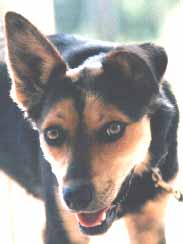
The majority of Kelpies have pricked ears but there are a growing number that don't. Many of these dogs with floppy ears have turned into excellent working dogs and some of the top Working Kelpies in the country are in that catagory. While pricked ears may be desirable by some, especially by pet people and people with show backgrounds, it is still very much a very secondary consideration in working dogs.
Unlike show dogs often the ears don't come up until the pup starts to mature. Sometimes as late as 12 months or even more, but usually by ten months. The ears on Kelpies are often not in proportion to the dog's head until the dog matures, often as late as two years.
We have seen Working Kelpies get their ears up at just a few weeks old. The most common would be around 4 - 8 months but others have not been completely pricked until they have been around 14 months old. Often the ears will come up and go down for a few months. One might be up and then down. This is especially true during a puppies teething process or if the young dog has not been well.
Ears and other cosmetic points are not considered a priority by breeders of working dogs. Natural working ability comes first and of course other important things like behaviour, stamina, intelligence, agility etc should all be more important in a working breeding program than cosmetic attributes.
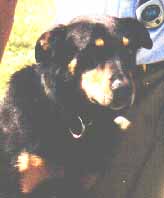
Kararana Chad is a Working Kelpie with flopped over ears. Even so, he has been used as a sire by many other Kelpie Studs and has been an excellent worker and breeder for his owner, Kevin Howell. He was won or placed in over 40 Yard Sheepdog Trials, making him one of the country's top trial performers. Chad won the Canberra Championship in 2001.
Another well known lop-eared Working Kelpie was Joes Pride. This dog was bred by Joe Attenborough of Molong and trained by him. Pride was later sold to the well known Chris Stapleton of the Capree Stud and used as a major sire for a period as well as winning and placing in Sheepdog Trials. He can be found in many pedigrees today. His sire was the famous Barambogie Mack.
Alinta Kira is a lop-eared Kelpie that is currently competing in Agility Trials. Clovaville Boska is another good Kelpie that has won and placed in Sheepdog trials and been used as a sire by the well known Meson and Croakes Kelpie Studs. There is also Puds Pace who has won major Yard Dog Trials and competed in sheepdog trials at National level and used a lot as a sire throughout Australia. Wyreema Oscar was another excellent farm-working purebred Kelpie with floppy ears. There would be hundreds of others as well.
Many of the better known breeders had Kelpies with big ears. Rockybar Stud and Liscannor were well known for it. There was also Barambogie, Le Cliff, Karrawarra, Milburn, Beloka, U.D., Karrobar, Capree, Scoriochre, Avenpart and many others. Le Cliff Gabee was a Kelpie we used many years ago. She had the biggest and widest ears of any dog we can remember but she also had some of the best natural working ability of any dog we had seen. Famous dogs like Milburn Basil and Milburn Mack have slightly soft ears at the top too. Barambogie Chance, the famous trial Kelpie was another.
Barambogie Chance was a well known trial winner and sire in the 1980's and 90's. He was second placegetter at the 1990 National Open Kelpie trial. He like many Kelpies had one tipped ear.
The last thing the Working Kelpie breed needs is for owners and breeders to get hung-up on physical looks and start making looks a priority. These are not show dogs and there are many other things that are more important in a dog than perfect ears, eyes, tail, head shape, size or perfect markings or coat colour.
Here are some comments on Working Kelpie ears from the International Working Kelpie Club's Discussion Forum (reprinted with permission)
"I've never seen Joe's Pride but have
heard that he had big floppy ears too. No one worries
about ears here, I've never heard of anyone taping Kelpie's ears to make them
stand up as happens with show dogs. You'd need a whole lot of tape on some dogs
I've seen. Cathy
"This made me laugh. I occasionally
read another Kelpie list (mostly herding, and mostly USA) who weren't very
complimentary about me doing agility with a Working Kelpie. When they had a
very lengthy discussion about the best way to tape their 'working' Kelpies ears
I nearly fell off my chair. I was slightly baffled as to how it would improve
their working performance."
Anna
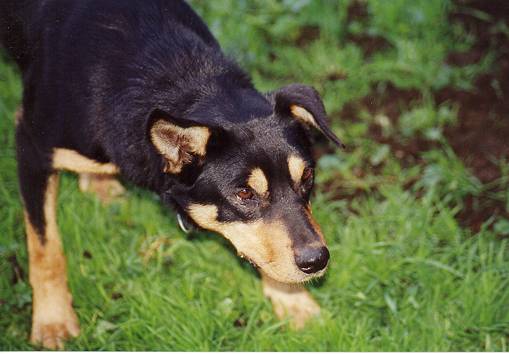
Capree Boss II - One of
Australia's Famous Kelpies
WHAT SHOULD A KELPIE TAIL LOOK LIKE ?
Here is another question we often get. We think it is so unimportant we are surprised that it is even talked about.
Most people want to know whether a Working Kelpie tail should be smooth haired or very bushy like a Fox or Dingo. It doesn't really matter. From photos going way back into the past both types of tail have been common in the breed. We have seen both tails on thousands of Kelpies and both are very common. Even in our own breeding we get both sorts.
Noonbarra Tina (now deceased) had a long smooth haired tail as does her daughter, Noonbarra Wendy. On the other hand, Noonbarra Gabe had a slightly shorter bushy tail as does Noonbarra Dusty. Of course some tails are a bit in between. Both Gabe and his grandson Noonbarra Dusty had a very dry tail.
The Kelpie does not naturally ever have a bob-tail nor is the tail docked.
Other questions about tails is on the length of the tail. Once again it doesn't matter much. The famous Old Kalari Basil had a short tail compared to many of the Working Kelpies in his day. What we wouldn't give to have a dog of his calibre in our Stud today.
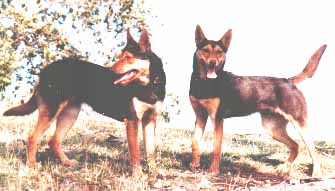
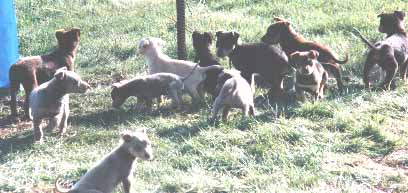
More information on Kelpie history can be found
in the latest edition of our book
We also have our new 2007 edition of The Rockybar Kelpies available
THE ROCKYBAR KELPIES
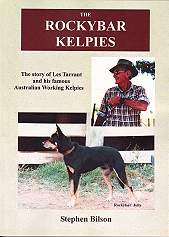
New for 2007, Kelpie history, Kelpie training, Kelpie breeding and great stories all from one of Australia's past best known Australian Working Kelpie Studs.
CLICK HERE FOR MORE INFORMATION
New 3rd edition of this very popular manual designed for all Kelpie owners of every level from raw beginners through to experienced trainers. This practical manual deals with everything involved in owning and training a Kelpie to ensure he grows up to be a well mannered, obedient dog.
The book is not about training on livestock! It deals with general obedience training, socialising your Kelpie, feeding, crating, toilet training, preventing problem behaviour, dominance issues, car travel, bathing, digging holes, stealing food, walking on a lead, coming when called... and much more.
Over 100 pages.
